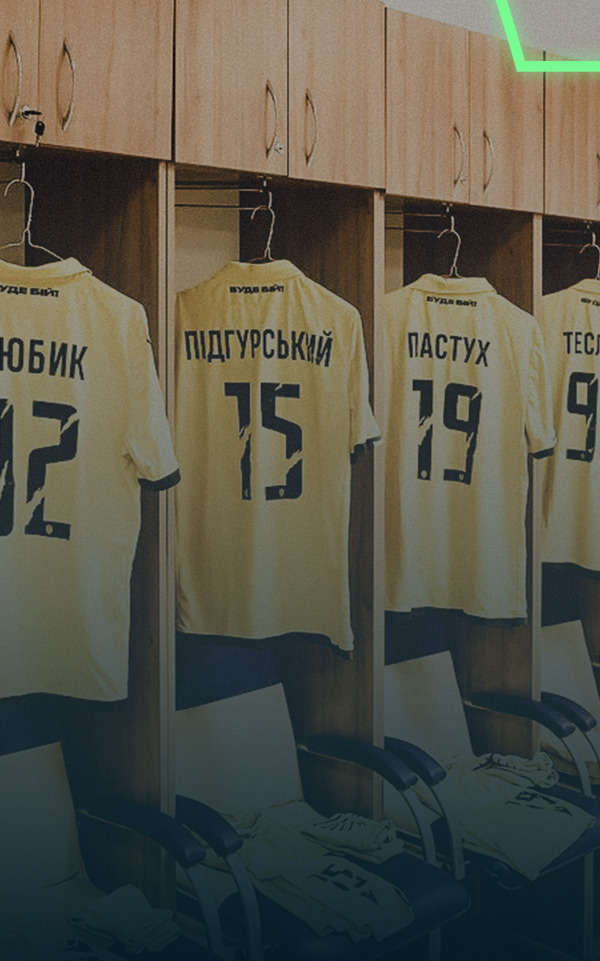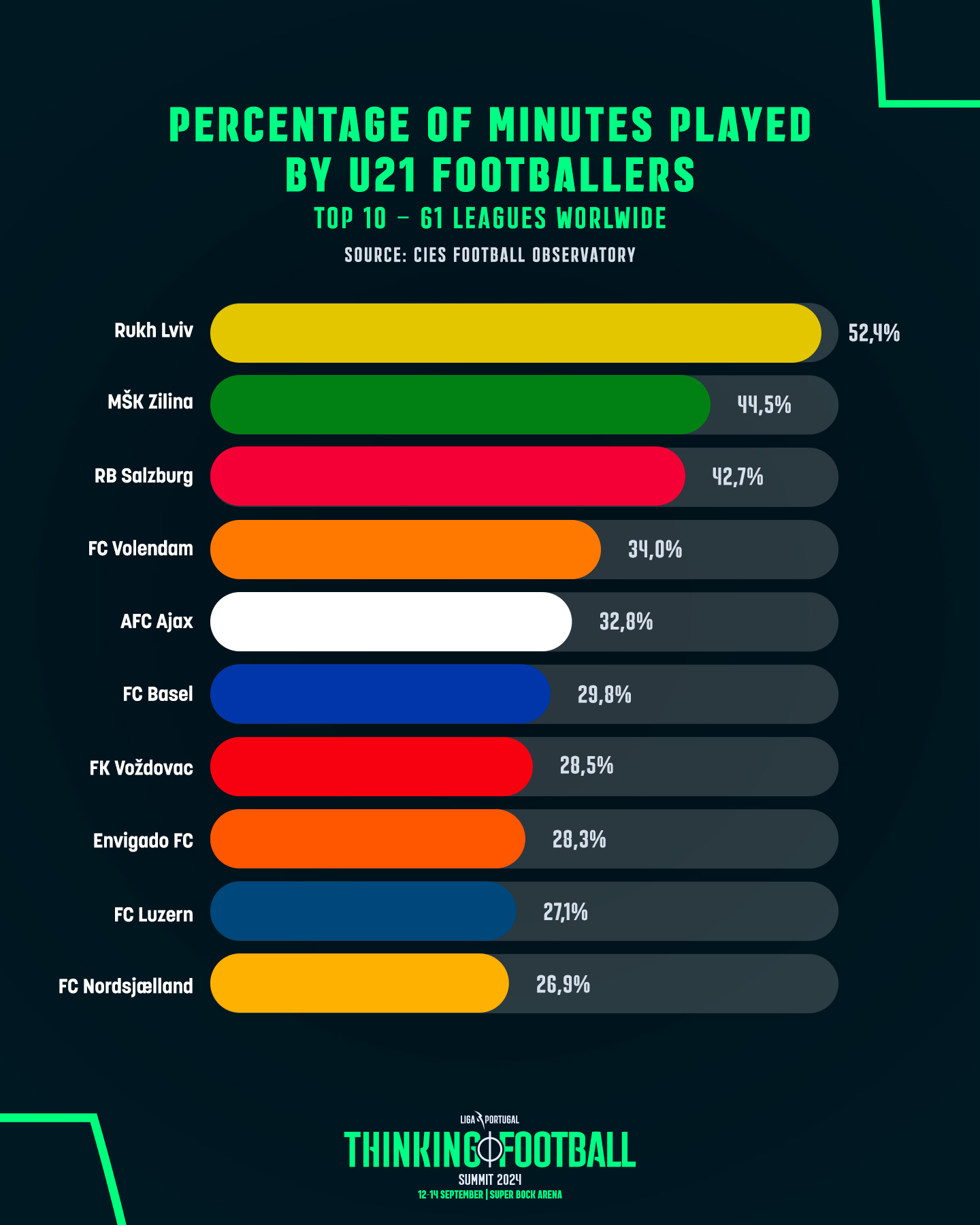Which leagues give the most opportunities to young players?

Which leagues give the most opportunities to young players?
In a week marked by young talent, culminating with the UEFA Youth League final, we sought to examine the paradigm of youth in football, attempting to answer the question: in which clubs, leagues, and countries do the youngest players get more playing time in senior teams?
The answer lies in a report published by the Football Observatory of the Centre International d'Etude du Sport (CIES), which compiled game data from the last year (between April 3, 2023, and April 2, 2024) regarding the utilization of under-21 players in 61 leagues worldwide. This work resulted in a ranking that analyses the percentage of minutes played by these young athletes, with breakdowns for the under-19, under-20, and under-23 age groups.
According to the study, the club within the universe of the 61 analyzed leagues, where under-21 players had the highest percentage of playing time in their respective domestic league, is Rukh Lviv from Ukraine, with 52.4%, followed, also in Eastern Europe, by MŠK Žilina from Slovakia, with 44.5%. The podium is completed with RB Salzburg with 42.7%.
If we lower the age for analysis to under-19, the paradigm shifts: first place goes to Adelaide United FC from Australia, where players up to 19 years old had a playing time percentage of 14.9%. Next is FK IMT from Serbia, with 11.6%, and NK Domžale from Slovenia, with 11.3%.

How much playing time do players from the most lucrative academies in the world have?
A report also from CIES, earlier this year, identifies the most profitable academies in the world. They are: AFC Ajax (Netherlands), SL Benfica (Portugal), Olympique Lyonnais (France), AS Monaco (France), Chelsea FC (England), Real Madrid CF (Spain), Sporting CP (Portugal), Tottenham FC (England), Manchester City (England), and Atalanta BC (Italy).
Many of these academies are historic, just think of academies like AFC Ajax and Sporting CP, which evoke names like Johan Cruyff, Paulo Futre, Luís Figo, or Cristiano Ronaldo in our imagination, and therefore, the importance of understanding the space that young players trained here have in the main teams is emphasized.
Of the above-mentioned academies, AFC Ajax stands out as the club that gives the most playing time to young players, with the under-21s under review in their main team (32.8%). Next is Olympique Lyonnais (23.2%), SL Benfica (16.1%), and Chelsea (11.1%), still with playing time percentages for young players in the double digits.
The last six positions are occupied by Atalanta BC (8.9%), Real Madrid FC and Sporting CP (8.2%), AS Monaco (8%), Tottenham FC (3.2%), and Manchester City (2.9%).
Big Five: In the biggest leagues, which clubs do young players manage to get more playing time?
Analyzing the five biggest leagues (Premier League/England, LaLiga/Spain, Serie A/Italy, Bundesliga/Germany, and Ligue 1/France), RC Strasbourg (FRA) stands out as the club with the highest percentage of playing time for under-21 players, followed by the also French Olympique Lyonnais (23.2%). The podium closes with FC Barcelona (22%).
The remaining seven places continue to be dominated by the same flags of the top 3, with two exceptions. English side Brighton and Hove take fourth place (16.5%), Valencia CF (ESP) in fifth place with 15.6%, followed by Girona (ESP/14.2%), FC Lorient (FRA/13.2%), Tolouse FC (FRA/13.1%), FC Metz (FRA/12%), and closing the top 10, RB Leipzig from Germany, with 12%.

The reality outside Europe
Among the clubs from the 24 non-European leagues analyzed, the highest values were recorded by Envigado from Colombia for under-21 players (28.3%), Adelaide United from Australia for under-19 (14.9%) and under-20 (21.9%) age groups, and CEIF Fortaleza for under-22 (38.7%) and under-23 (62.1%) age groups.
If we look at the overall ranking of playing time for under-21 players in the 61 analyzed leagues, among the top 21 clubs, only one integrates the so-called Big Five, RC Strasbourg (FRA). If we lower the bar for under-19s, two clubs from the Big Five appear, Toulouse FC (FRA) and FC Barcelona (ESP). If the analysis is on under-20, under-22, and under-23 players, we find no clubs from the five major leagues among the top 21, which shows that England, France, Spain, Germany, and Italy are stages where minutes are also earned later, unlike many of the leagues that surround them, and that, in the European case, compete with the Big Five in European competitions, which rely on emerging talent not only to compete but to stay alive.
In a quick analysis of clubs where under-21 players have more playing time, we find RB Salbzurg, which launched Erling Haaland on the main stages, as well as names like Sadio Mané, Nabi Keita, or Dominik Szoboszlai, Ajax, responsible recently for the training of names like Matthijs de Ligt or Frenkie de Jong, and even FC Basel, which, in the last decade, launched names like Mohamed Salah, Manuel Akanji, or Embolo.
Investing in young players not only draws a map of opportunities but also presents the structures of club and competition realities, as well as projects that are based on a line of continuity between training and the senior team. Will this reality continue in the future? Will we see the Big Five opening up more to young talent? The future of training and investing in young players will be one of the topics under discussion at the 2024 edition of the Thinking Football Summit.
News
Historic: Women's football clubs surpass €100 Million in revenue
For the first time ever, the combined revenue of top women’s football clubs in key markets has exceeded ...
How to succeed in the Sports Industry? Four tips from Rafael Nadal
Rafael Nadal is renowned for his excellence, determination, and relentless pursuit of victory. With 22 Grand Slam ...
Al-Nassr signs Esports player for record-breaking fee
João Afonso, world champion in FIFA and EA Sports FC, known as "Jafonso," has made history with the most ...
Is Netflix prepared to stream major sporting events? Insights from the Jake Paul vs. Mike Tyson fight
The live broadcast of the Jake Paul vs. Mike Tyson boxing match on Netflix marked a significant step for the platform, ...
European Leagues and FIFPro vs. FIFA: Lawyer Gonçalo Almeida explains the complaint to the European Commission
The European Leagues, chaired by Pedro Proença, along with FIFPro, has filed a complaint with the European ...
